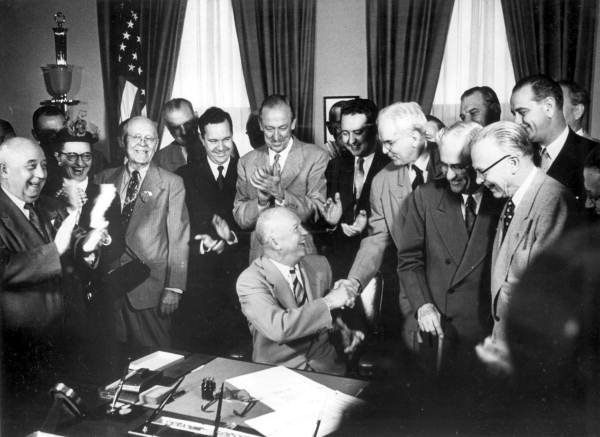
The postwar era was a time defined by unprecedented prosperity. Following the Second World War, returning GI’s came home to a booming economy, housing development projects, and support programs like the GI Bill that expanded and cemented America’s middle class. By 1950 most factories, including auto manufacturers, had made the transition from wartime production to a consumer-based economy, so much so that, in that year alone, 8 million cars were produced, by 1958 more than 67 million cars would be produced and registered in the United States. However, at the start of the decade, most of America’s obsolete roads were in no condition to support a massive inflow of traffic. Pressure for construction of transcontinental superhighways had been growing since the late 1930s, however, conflict between urban interests and rural interests vying for priority and a lack of funding left early projects such as the 1944 Federal-Aid Highway Act dead in the water. By the 1950’s, in order to manage an influx of new car owners president Dwight D. Eisenhower publicly supported an interstate highway development program and on June 29, 1956, he signed the Highway Revenue Act also known as the National Interstate and Defense Highways Act into law. The act marked the largest American public works program of that time authorizing the construction of 41,000 miles of interstate highways fitted with overpasses and limited-access belt lines. Eisenhower had been heavily influenced by his experiences in 1919 as a participant in the U.S. Army's first Transcontinental Motor Convoy across the United States and his observations of the German audubon highway network during World War II. Having recognized the importance of mobility and efficiency, Eisenhower proposed an American interstate highway system in his State of the Union address in 1954, which he framed as a national defense program. In an effort to encourage a cooperative alliance between state and federal officials, retired General Lucius D. Clay, an engineer and a long-time advisor to the president, proposed a plan in which the federal government would pay 90 percent of the cost of expressway construction; the funding for which would come from an increased gasoline tax (now 3 cents a gallon). Interstate funds were to then be distributed in the ratio of each state's estimated cost of completing the system. The first project under the Act was the Mark Twain Expressway (Interstate 70) in St. Charles County, Missouri.
The highways were intended to eliminate traffic congestion; replace “undesirable slum areas with pristine ribbons of concrete” as one highway advocate put it; make coast-to-coast transportation more efficient; and make it easy to evacuate big cities in case of an atomic attack. While transformative, the Highway Revenue Act also reflected an enduring legacy of Jim Crow era discriminatory policies and systemic racism. Low-cost mortgages through the G.I. Bill (which was not offered to black GI’s), enabled white families to abandon inner cities in favor of suburban housing as well as prevent ethnic minorities from doing the same. Federal planners of the interstate highway system routed some highways directly, and often purposefully, through predominantly black and brown neighborhoods to predominantly white suburban neighborhoods. Although the Highway Revenue Act was initially met with widespread public support, as more people became displaced and conditions in cities deteriorated, activists began to openly oppose the system, some going as far as forcing construction stoppages throughout the late 1950s and early 60s. During the 1960s, civil rights activists and environmentalists across the country in New York City, Baltimore, Washington, D.C. New Orleans and other cities managed to prevent roadbuilders from dividing and subjugating their neighborhoods, eventually however, most of the 41,000 miles of interstate were completed.
Sources:
https://www.senate.gov/artandhistory/history/minute/Federal_Highway_Act.htm#:~:text=On%20June%2026%2C%201956%2C%20the,Eisenhower%20signed%20it%20into%20law.
https://www.npr.org/2021/04/07/984784455/a-brief-history-of-how-racism-shaped-interstate-highways
https://www.theatlantic.com/business/archive/2016/03/role-of-highways-in-american-poverty/474282/
https://highways.dot.gov/public-roads/summer-1996/federal-aid-highway-act-1956-creating-interstate-system
